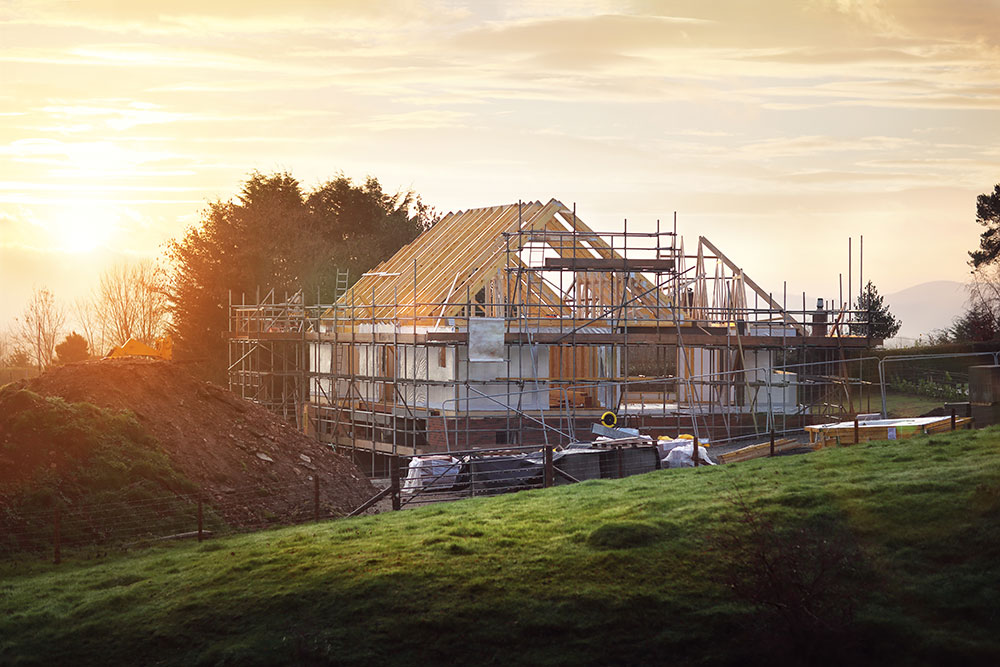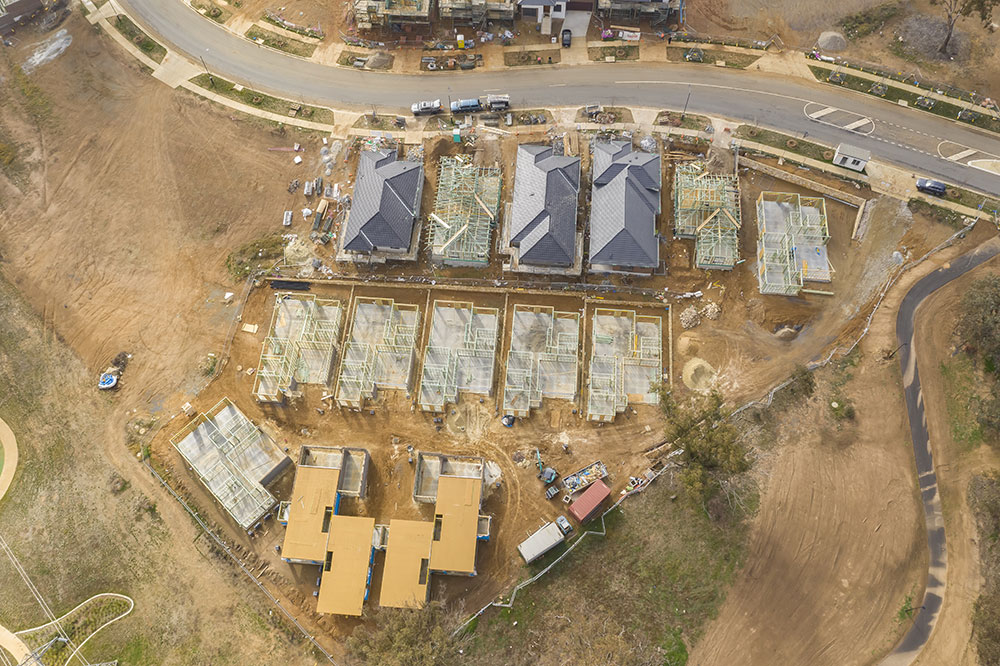Private Lending for Property Development in Australia

Updated 23rd November 2022
Property development or real estate development involves the value of additional activities applied to land to increase its value. That includes activities such as building a building from scratch, converting an existing property to serve a different function from its original function, and renovating an existing property. The addition of value to property allows developers to increase income from the property.
Although some developers may have an extensive range of development services, most prefer to focus on one area of property development. For instance, one may focus on residential property while another may prefer doing commercial property development. Those whose services may overlap, may develop one type of property and incorporate another into it. For instance, while developing residential property, a developer may incorporate a commercial aspect into it such as having shops within the residential property. Such developments help accommodate different aspects of the community.
While profit is one of the benefits of property development, it is not the only benefit. Property development can also increase social value. The development of housing and other facilities such as educational facilities, hospitals, and places of work help improve the community around the developments.
In most instances, property developers acquire property such as homes, land, stores, and office space and raise their value to sell them later at a higher price. To maximize the value of a property, some of the things a developer can do include refurbishing the kitchen or bathroom of a home, converting the loft or basement, improving the interior and exterior design, adding a new garden or swimming pool, new plumbing and electric connections, and making the home more energy efficient.
Property development involves a range of professionals carrying out different functions to ensure the success of the development. From the person that ensures adherence to relevant policies to the person seeking plan permits, the people doing the actual building of the property, and the one accounting for the project costs. Some of the professionals involved include a planning consultant, quantity surveyor, solicitor, accountant, interior designer, architect, and contractors. There is also a need for a project manager to oversee the entire project.
Funding a property development project often depends on the type of property and the developer’s financing situation. If one is developing personal property, their savings may suffice. However, for large-scale projects, one may need a property development loan to fund the project. You can approach the bank for a mortgage. You can also seek private funding for property development from a specialist finance company or private investors.
Before commencing any property development project, one of the most crucial factors to consider is your budget. If you need financial help, you should first know how much you can borrow. At the same time, you should also know if you can manage all the costs involved.
Property developers should understand finance. Banks have certain criteria before they lend money for your project:
- Your risk level
- Reputation
- Security of the project
- The track record of those involved in the development
Unfortunately, it is not the same as their assessment for buy-and-hold financing. In general, the development loan application is structured in a way that may convince banks to provide 70 to 80 per cent of the total cost of the project.
Today, many Australians know that banks and other traditional lenders are not too keen on letting them borrow money. Major financial organisations take a look at the risk level of the borrower. The problem is that several Australians have a high risk. Banks see it as an opportunity for them to decline the loan application, even though these individuals can repay the loan.
What is Property Development Financing?
As the name suggests, a property development loan is a type of short-term loan that provides financial assistance for the development of a property. Property development includes land purchase, renovation, construction, and many others. It can either be a residential or commercial project.
When is This Type of Loan Appropriate to Use?
Both large and small-scale projects can take advantage of a property development loan. However, it is more suited for large-scale projects. When you apply for this loan, you can only get up to 80% overage of the whole construction cost. The remaining balance should be shouldered by the management that handles the project.
What are the Benefits of Property Development Loans?
Aside from getting up to 80% loan to value ratio, a property development loan allows you to obtain a high return on your investment. One great benefit, however, is that this type of loan does not require the land where you are building or renovating the property to be used as the collateral.
Interest payments are also tax-deductible, which helps keep your cash flow controlled. There are different types of this loan, so you can choose which among them suits your situation.
What Can You Do with a Property Development Loan?
The sky is the limit with this type of loan. Borrowers can use the money to help fund a residential subdivision, multi-housing, townhouse, or office space developments. It can also be used for retail outlets and hospitality construction, such as hotels and resorts.
A property development loan is applicable for those whose purpose is to invest in the property, as well as those who will become the owner-occupier.
Why is Private Lending in Property Development Loans Increasing in Australia?
Many commercial and residential projects are happening in Australia. Some are in the private sector, while others are already in the different stages of the construction process (to learn more about this, visit Steel Frames WA). Others still require approval and some have accomplished the preliminary building activities.
In 2017, office projects under construction across the country were worth about $20 billion. The biggest was in New South Wales, specifically the $6 billion development in Barangaroo. The past few years showed that Western Sydney had the most number of property development projects. From the Sydney Metro City and Southwest to the Westconnes to the Western Sydney Airport, there have been a lot of developments in the area.
Meanwhile, Western Australia is also booming. By the end of 2018, there were more than 600 applications for both residential and commercial developments in the state. These numbers represented a two per cent increase in residential and six per cent in non-residential projects.
The emergence of affordable housing plan has also influenced the surge in numbers of construction in the area, as well as other parts of Australia. Unfortunately, property development is an expensive endeavour. Commitment and hard work are not enough because funding is key to the completion of any project, whether residential or commercial.
Even big companies can have financial trials that can affect the entire project. It is why funding should be taken care of before the beginning of the development process.
Banks, however, can be quite discerning when accepting applications and approving them. They would typically assess certain factors, including:
- The sale price of the collateral
- The end value of the property in the current development
- Zoning security
- Size of the property
- The location of the borrower
It also takes longer to get approved from banks and other traditional lenders. The plan may look undeniably wonderful on paper. However, if it is not up to the bank’s standards, it may not even get off the ground.
With such a dilemma, property developers in the country looked for other ways to gain financial backing. Eventually, they found comfort in knowing many private lenders are willing to provide funding as banks tighten their requirements.
The rules have become much stricter, making it almost impossible for some people to borrow. The tightening caused the opening up of a fourth lending tier in the form of these private lending companies or individuals. They provide financial support for borrowers looking to start and complete their property development projects.
With firms, such as Quantum Finance, investors get the help they need to find and buy a property. A finance broker is often readily available to help secure the funding.
Factors, such as the cap on interest-only loans as imposed by the Australian Prudential Regulation Authority (APRA), have slowed down the ability of borrowers to get some financial assistance. APRA did later lift the cap but experts stated that it may not cause any changes. After all, banks are more cautious than ever.
Add to that, the Royal Commission issue made it even more challenging for property developers to borrow money. Despite the main purpose, which was to help borrowers, banks have changed the way they handle loan applications.
The goal of the conventional lenders is to make sure the applicants’ ability to repay is checked thoroughly, which includes their income and expenses. Therefore, the application process is even longer than before with all the assessments they have to do. The problem is that many property development projects are delayed while they wait for the banks’ financial support.
Investors and property developers searching for a construction loan and other types of property development loans now opt for private lenders. The rise in approvals from these lenders made them the ideal choice for those who would have received a “No” from banks.
The Loan Markets in Australia and the Role of Private Lenders
For people who believe banks are a good option for them would declare that traditional lending has lower interest rates. It is indeed the reality where banks would normally offer a five to six per cent interest, depending on the credit background of the borrower among many other factors.
As for private lending, the interest rates are higher, going 10% or even more. However, the benefit is that the approval is much quicker and easier. Also, borrowers who choose interest-only loans, despite having a higher interest rate, can get more benefits. Many consumers find it difficult to plan their budgets properly. Therefore, they end up having less money to pay for their loan or mortgage.
With an interest-only loan, the only concern is the interest, which should be paid first instead of a portion of the whole loan, along with the interest. The payments are much smaller, allowing the borrowers to manage their other investments.
Interest-only loans also let borrowers take advantage of tax deductions while controlling their fund disbursement.
Meanwhile, some lenders would still stick to the 30% threshold that APRA has already removed for interest-only loans. Investors must work with a mortgage broker that has up-to-date information about banks and other lending institutions.
The reality is that major banks still have the cap even though APRA has done so. Banks still assess interest-only loans using their old methods.
As the Banking Royal Commission stirred up regulatory changes, it is clear that alternative lending will continue to increase. The Basel Committee also amplified the market risk capital requirements, which has clearly affected the lending landscape.
During the last few years, the loan market in Australia was quite strong, especially with the ongoing backing for the investment-grade credits. Some of the key features included the volume of underwritten loans that come from institutional lenders as well as the banks. They were quite spread across different industries, with acquisition finance as one of the main drivers.
The stable market conditions also showed traditional lenders are no longer the primary choice of the borrowers. With the rise of several other private lending individuals, companies, and groups, funding for property development has continued to extend even to those borrowers with less satisfactory credit ratings.
These conditions gave way to the borrowers enjoying the upside of the battle between private lenders and banks:
- There is competitive pricing among many sectors, including infrastructure borrowers where pricing can reach up to 30 basis points within the broader market.
- Although property development loans are short-term loans, they can provide support for longer terms.
- Borrowers also gain headroom in debt-sizing and financial contracts.
- Another benefit is having more transactions that they can arrange on their own.
The outlook for institutional and corporate borrowers may not be in good shape right now. For example, Australian banks now have tighter lending standards, along with the improvement of ethical behaviour. While these two modifications are beneficial for the consumers, it could result in lower loan applications.
The Basel Committee has also approved the increase of minimum capital requirements for banks in January and February 2019. Bank regulators, such as APRA, could also increase the total market risk capital requirements to correspond with the Basel 2.5 framework.
The mentioned increase will still have to wait until early 2020. However, it can already be seen that banks have taken compliance steps. The future may be unclear for the loan markets in the country, but it could have a huge effect on the availability of bank credit for the borrowers, especially for longer tenors.
On the other hand, the demand for financial help from alternative lenders, such as private lending groups, will continue to soar for the foreseeable future. For one, the funds are under management while some have benefited from increased access. The composition of lending syndicates may see some changes but the loan credit availability will not be difficult unlike with banks.
According to the Asia Pacific Region Alternative Finance Industry Report, Australia is where the largest alternative finance market in the online world exists. The exception is China but the Australian online finance market has 36 platforms with more than $1.6 billion in 2017. This amount may still be small compared to other bigger markets in other parts of the world; the average growth in the country was 88% during that specific year. Balance sheet business lending had the largest share while P2P or marketplace consumer lending follows.
What Types of Property Development Loans Can You Borrow from Private Lenders?
Property development can be financed through a variety of loan options from private lenders. Whether you are an investor, a property developer, or even a landlord, you can get the financial assistance you need that will help kickstart your project.
It helps to know the different kinds of loans that borrowers can choose from for their property development projects. These options include:
- Commercial Mortgages: If you plan to purchase a commercial property, such as shops, warehouses, or anything that is not private residential property. This type of loan option helps you spread the cost of a huge investment over a certain period. If you have applied for a private mortgage before, this property development loan works almost the same way.
- Buy-to-Let Mortgages: For landlords with a large property portfolio, this type of loan may be suitable in case more properties are needed for purchase. Combining several properties is the key to cut arrangement fees.
- Auction Finance: One rapid method of getting a property, especially at a discounted price is through an auction. You can find a lender that specialises in this type of purchase where you can get the financial backing you need to win the bid. Normally though, you will only have less than a month or 28 days to grab the auction house. Therefore, you should look to secure funding before the period ends.
- Bridging Finance: This type of loan is often confused with the property development loan itself. Bridging allows you to pay for construction, as well as other costs during the development process. The terms may seem interchangeable but they are significant differences between them, including the size of the project.
If you are looking for a property development loan to fund your construction project, it will help to determine first the “heaviness” of the project. It is usually categorised into three:
- Light refurbishment: As the most straightforward project type, consumers will simply perform different primary changes, mainly the appearance or aesthetics of the property. It usually does not involve structural modifications, although light refurbishment may include working on ceilings, walls, and floors of the property.
- Heavy renovation: As the name suggests, you will require more than aesthetic changes for this process. It may include moving internal walls, electric wiring, and plumbing work. The renovation usually involves tearing down internal or external walls – or both – along with adding more rooms into the property. Rebuilding may be a part of the procedure or at least partial demolition.
- Ground-up: A property project that requires the most involvement is a ground-up development. It typically starts with an empty parcel of land, although it can also involve heavy refurbishment. The difference is that only stonework will remain after the conversion or job.
The terminologies in developing properties are not strictly defined, however. Some people may consider a particular project as a simple or light refurbishment but others may think it is a heavy renovation. It can be somewhat confusing, especially for beginners in financing the property.
For light renovations, a private lender may provide three to 24 months of funding, including building costs. Some even allow consumers to switch to another mortgage option later, making it easier to cover light to heavy refurbishments.
Property development finance, as mentioned early in this post, is much better for extensive projects, including ground-up developments. With this type of loan, it becomes much easier to cover land purchases, along with the costs of the construction. Developers who want to purchase a piece of land for $100,000 and $500,000 for building the property could get funding from a lender for both purposes. For example, the lender could finance 70% for the construction costs and about 40% on the land purchase.
Property development loans make it easy for the developer, landlord, homeowner, or investor to fund their project. Instead of paying the whole project costs, these loans help free up personal capital for unexpected expenses or even another project.
Quantum Capital Australia are experts in a number of private lending areas, we can help you fund your next project, venture or redo your finances. Get in touch today to discuss more.


